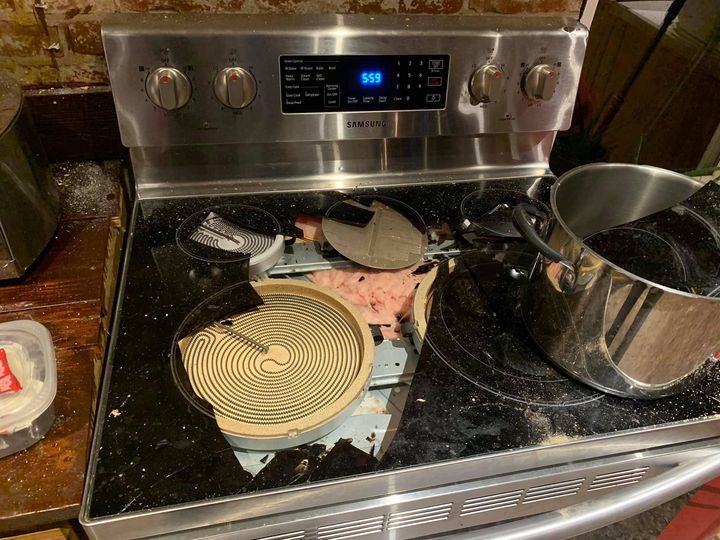Glass top stoves have become a staple in modern kitchens, admired for their sleek, contemporary design and effortless cleaning experience. Their smooth surfaces not only elevate the kitchen’s aesthetic but also eliminate the annoying crevices found in traditional coil burners, where food debris and grease can hide. With just a quick wipe, these cooktops can look brand new again. However, despite their polished appearance and advanced construction, glass top stoves are not indestructible. They come with unique vulnerabilities, and one common yet often overlooked mistake—placing a hot lid directly on the glass surface—can lead to expensive damage, including cracks or even catastrophic shattering.

At first glance, placing a hot lid on your glass stove might seem harmless. After all, the cooktop is designed to endure extreme heat, right? Unfortunately, this simple action can set off a chain reaction of events that could result in permanent damage. The issue lies in how heat interacts with the glass surface and the hot lid. When a heated lid is placed face-down on the cool glass cooktop, heat gets trapped between the two surfaces. This trapped heat can create a vacuum seal, effectively locking the lid in place. As the cooktop begins to cool, the temperature difference causes uneven pressure on the glass. Over time, this pressure weakens the glass’s structural integrity, resulting in spiderweb-like cracks or, in the worst cases, a completely shattered cooktop.
While the initial damage might not always be immediately visible, the problem often worsens with continued use. A small crack can grow into a large fracture as heat cycles through the stove during cooking. These cracks aren’t just a cosmetic concern—they pose significant safety hazards.
First and foremost, a cracked glass cooktop compromises the stove’s structural integrity. Under the right conditions—like high heat or additional pressure—the glass could shatter unexpectedly, sending sharp shards flying. Not only is this dangerous, but it also renders the stove unusable. Additionally, cracks can interfere with the stove’s heating elements, causing them to malfunction or heat unevenly. This inconsistency can lead to poorly cooked meals or even burnt food. More critically, cracks may expose the stove’s electrical components, creating a risk of electric shock or even a fire hazard.
So, how can you prevent this costly and potentially dangerous issue? Fortunately, it’s not difficult to protect your glass top stove. A few simple precautions can go a long way in preserving its lifespan and functionality.
First, never place a hot lid directly on the cooktop. Always use a heat-resistant trivet or set the lid on a cool countertop instead. This simple habit prevents the vacuum seal effect and eliminates the risk of uneven pressure buildup.
Second, choose the right cookware. Opt for pots and pans with smooth, flat bottoms. Uneven or rough cookware can scratch the glass surface, weakening it over time. Additionally, heavy cookware, such as cast iron, should be handled carefully. A single accidental drop can crack the glass instantly.
Third, clean your cooktop regularly. After each use, make it a habit to wipe down the surface. Food residue and grease can become abrasive when burned onto the surface, causing tiny scratches that compromise the glass’s durability. Use gentle, non-abrasive cleaners specifically designed for glass top stoves to avoid further damage.
Fourth, be mindful of weight limits. While the tempered glass is sturdy, it isn’t designed to support excessive weight. Avoid placing heavy appliances, large pots of water, or other bulky items on the stove surface.
But what if, despite your best efforts, your glass cooktop develops a crack? The first and most important step is to stop using the stove immediately. Continuing to cook on a damaged surface can worsen the crack, increase safety risks, and possibly damage the internal components of the stove.
Next, assess the damage. Minor hairline cracks might be repairable, but larger cracks, deep fractures, or spiderweb patterns typically require a full replacement.
After assessing the damage, call a professional technician. DIY fixes might be tempting, but glass cooktops require specialized knowledge and tools for proper repair or replacement. A certified technician can accurately evaluate the damage and recommend the safest course of action.
In many cases, replacing the glass cooktop entirely is the most reliable solution, especially if the cracks pose a risk to electrical components or structural integrity. While replacement can be costly, it’s a necessary investment in both safety and functionality.
Glass top stoves are undoubtedly a stylish and functional addition to any kitchen, but they aren’t indestructible. Protecting them requires mindfulness and simple preventative measures. Avoiding common mistakes, like placing hot lids on the surface, and following good maintenance practices will help extend the life of your appliance and keep it looking flawless.
The next time you’re cooking, take an extra moment to treat your glass cooktop with care. Whether it’s using the right cookware, avoiding heavy weights, or simply being cautious with hot lids, these small efforts add up to long-term protection. After all, a little prevention today can save you from a hefty repair bill tomorrow. Your glass top stove isn’t just another kitchen appliance—it’s an investment in your home, and with proper care, it can serve you beautifully for years to come.





